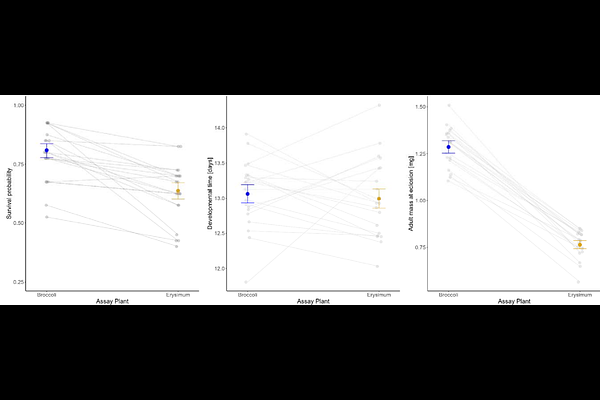Evolutionary constraints in host shifts: limited adaptation of Plutella xylostella to cardenolide-defended Erysimum cheiranthoides

Evolutionary constraints in host shifts: limited adaptation of Plutella xylostella to cardenolide-defended Erysimum cheiranthoides
Biswas, B.; van Bergen, E.; Vaello, T.; Daellenbach, L. J.; Wheat, C. W.; Zuest, T.
Abstract1. Plants and herbivorous insects are engaged in long-term coevolutionary arms races, where gains in novel plant defences and corresponding adaptations in herbivores may drive evolutionary change. One such recent innovation is the gain of cardenolide toxins in the Brassicaceae genus Erysimum, which resulted in the effective deterrence of most herbivores by these plants. Nonetheless, some herbivores continue to attack Erysimum, likely by tolerating cardenolide defences through general detoxification mechanisms that may serve as evolutionary stepping-stones for more specialized resistance. 2. We investigated the interaction between diamondback moth (DBM, Plutella xylostella) and its occasional host plant E. cheiranthoides, by first screening the standing variation in DBM performance, and second by experimentally evolving DBM populations for increased performance on Erysimum. Despite considerable variation among wild DBM populations, larvae consistently avoided Erysimum leaves for feeding, and when constrained to Erysimum, they exhibited reduced growth rate, survival, and lower adult size compared to individuals feeding on control broccoli plants. 3. Surprisingly, cardenolides could only partly explain the reduced performance of DBM on Erysimum, and experimental evolution failed to improve overall performance. Instead, phenotypes of evolved lines converged on what appears to be a pre-existing, highly plastic phenotype found among wild DBM ancestors and which is characterized by rapid development and high weight gain on control plants, but slow development and low weight gain on Erysimum. 4. Although DBM failed to evolve improved performance on Erysimum, our results demonstrate that its existing genetic variation and phenotypic plasticity are evidently sufficient to support long-term development on Erysimum, thereby fulfilling a key condition for the future evolution of specialized adaptations.